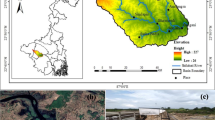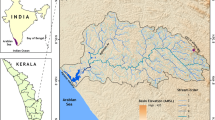Abstract
In arid and semi-arid area, groundwater is the most important water resources. Surface runoff harvesting is the most important process in the artificial recharge of groundwater that should increase groundwater quality and quantity. Urban impervious area provides an appropriate surface to produce adequate amounts of runoff. Groundwater recharge via recharge wells is one of the successful direct sub-surface methods. As many cities around the world face issues of water scarcity due to a fast and unsustainable urbanization, identify the best locations of groundwater recharge wells is an interesting relevant topic, especially in the arid and semi-arid area. Selection of a suitable area for groundwater recharge could increase efficiency of the recharge wells. In this study, the best location of recharge wells was investigated in Urmia city located in the North-west of Iran using fuzzy logic technique. In this study, locations of the drainage channel junctions with adequate potential of surface runoff were determined using SWMM. Appropriate locations for recharge wells were determined based on different layers including distance to runoff harvesting points, distance to the production water wells and depth of groundwater table. Hydraulic condition (hydraulic conductivity and specific recharge) was also used separately. The input layers were prepared using geostatistical interpolation techniques in ArcGIS 9.3 software. Mamdani fuzzy inference system was applied to incorporate the fuzzified input layers. Finally, in each area, pixels with the highest value were proposed as suitable locations for recharge wells. Based on the results, the number of pixels with “High” priorities increased when the hydraulic conductivity was used to site selection. Comparing hydraulic conductivity layer and selected location of the recharge wells shows that the area with low hydraulic conductivity and the area closed to the production water wells has not suitable priority for recharge wells.







Similar content being viewed by others
References
Azadi H, Van Den Berg J, Shahvali M, Hosseininia G (2009) Sustainable rangeland management using fuzzy logic: a case study in Southwest Iran. Agric Ecosyst Environ 131:193–200
Chenini I, Mammou AB, El May M (2010) Groundwater recharge zone mapping using GIS-based multi-criteria analysis: a case study in Central Tunisia (Maknassy Basin). Water Resour Manag 24:921–939
Contributors N, Kulongoski J, Massmann G, Newman B (2013) Using isotopes for design and monitoring of artificial recharge systems. International Atomic Energy Agency
Dietz ME, Clausen JC (2008) Stormwater runoff and export changes with development in a traditional and low impact subdivision. J Environ Manag 87:560–566
Ehsan S (2013) Utilization of storm runoff for groundwater recharge in urban areas-a case study of Gujranwala City in Pakistan. J Riv Eng 1:18–28
Ghalibaf MB, Moussavi Z (2014) Development and environment in Urmia Lake of Iran. Eur J Sustain Dev 3:219
Ghayoumian J, Saravi MM, Feiznia S, Nouri B, Malekian A (2007) Application of GIS techniques to determine areas most suitable for artificial groundwater recharge in a coastal aquifer in southern Iran. J Asian Earth Sci 30:364–374
Grint K (1997) Fuzzy management contemporary ideas and practices at work
Jang JSR, Sun CT, Mizutani E (1997) Neuro-fuzzy and soft computing, a computational approach to learning and machine intelligence
Lee CC (1990) Fuzzy logic in control systems: fuzzy logic controller. I. IEEE Trans Syst Man Cybern 20:404–418
Mamdani EH, Assilian S (1975) An experiment in linguistic synthesis with a fuzzy logic controller. Int J Man Mach Stud 7:1–13
Moody R, van Ast JA (2012) Implementation of GIS-based applications in water governance. Water Resour Manag 26:517–529
Narula A (2014) Feasibility of recharge shafts/injection wells for groundwater recharge in Patan district, Gujarat, India international journal of advanced research in engineering and. Appl Sci 3:10–19
Prabhu MV, Venkateswaran S (2015) Delineation of artificial recharge zones using geospatial techniques in Sarabanga Sub Basin Cauvery River, Tamil Nadu. Aquat Procedia 4:1265–1274
Rahimy P (2011) Effects of soil depth and saturated hydraulic conductivity spatial variation on runoff simulation by the Limburg Soil Erosion Model (LISEM), a case study in Faucon catchment, France France Effects of soil depth and saturated hydraulic conductivity spatial variation on runoff simulation by the Limburg Soil Erosion Model (LISEM), a case study in Faucon catchment, France
Riad PH, Billib MH, Hassan AA, Omar MA (2011a) Overlay weighted model and fuzzy logic to determine the best locations for artificial recharge of groundwater in a semi-Arid Area in Egypt Nile Basin. Water Sci Eng J 4:24–35
Riad PHS, Billib M, Hassan AA, Salam MA, El Din MN (2011b) Application of the overlay weighted model and Boolean Logic to Determination the best locations for artificial recharge of groundwater. J Urban Environ Eng 5. https://doi.org/10.4090/juee.2011.v5n2.057066
Ruspini E, Bonissone P, Pedrycz W (1998) Handbook of fuzzy computation (cited from introduction of chapter fuzzy models). Institute of Physics Publishing, Bristol and Philadelphia, p C 1:1–10
Saneifard R, Saneifard R (2011) A method for defuzzification based on centroid point. Turkish J Fuzzy Sys 2:36–44
Schoonover JE, Lockaby BG, Helms BS (2006) Impacts of land cover on stream hydrology in the West Georgia piedmont, USA. J Environ Qual 35:2123–2131
Senanayake I, Dissanayake D, Mayadunna B, Weerasekera W (2016) An approach to delineate groundwater recharge potential sites in Ambalantota, Sri Lanka using GIS techniques. Geosci Front 7:115–124
Singh LK, Jha MK, Chowdary V (2017) Multi-criteria analysis and GIS modeling for identifying prospective water harvesting and artificial recharge sites for sustainable water supply. J Clean Prod 142:1436–1456
Solomon S, Quiel F (2006) Groundwater study using remote sensing and geographic information systems (GIS) in the central highlands of Eritrea. Hydrogeol J 14:729–741
Todd DK, Mays LW (2005) Groundwater hydrology edition vol 1625. Wiley, Hoboken
Wang YM (2009) Centroid defuzzification and the maximizing set and minimizing set ranking based on alpha level sets. Comput Ind Eng 57:228–236
Wang Y, Choi W, Deal BM (2005) Long-term impacts of land-use change on non-point source pollutant loads for the St. Louis metropolitan area, USA. Environ Manag 35:194–205
Water GoARtG (2000) Central Ground Water Board. Ministry of Water Resources, New Dehli
Yeh HF, Lee CH, Hsu KC, Chang PH (2009) GIS for the assessment of the groundwater recharge potential zone. Environ Geol 58:185–195
Zadeh LA (1965) Fuzzy sets. Inf Control 8:338–353
Zadeh LA (1978) Fuzzy sets as a basis for a theory of possibility. Fuzzy Sets Syst 1:3–28
Zaidi FK, Nazzal Y, Ahmed I, Naeem M, Jafri MK (2015) Identification of potential artificial groundwater recharge zones in northwestern Saudi Arabia using GIS and Boolean logic. J Afr Earth Sci 111:156–169
Zedeh L (1973) Outline of a new approach to the analysis of complex systems and decision processes. IEEE Trans Syst Man Cybern 3:28–44
Zimmermann HJ (2010) Fuzzy set theory. Wiley Interdiscip Rev Comput Stat 2:317–332
Acknowledgements
This work was funded through the University of Kashan in Iran as a PhD thesis and by the Iranian National Science Foundation (Grant No: 95850079). The authors appreciate the University of Kashan and the Iranian National Science Foundation for their generous support.
Author information
Authors and Affiliations
Corresponding author
Ethics declarations
Conflict of Interest
None.
Rights and permissions
About this article
Cite this article
Ghazavi, R., Babaei, S. & Erfanian, M. Recharge Wells Site Selection for Artificial Groundwater Recharge in an Urban Area Using Fuzzy Logic Technique. Water Resour Manage 32, 3821–3834 (2018). https://doi.org/10.1007/s11269-018-2020-7
Received:
Accepted:
Published:
Issue Date:
DOI: https://doi.org/10.1007/s11269-018-2020-7




